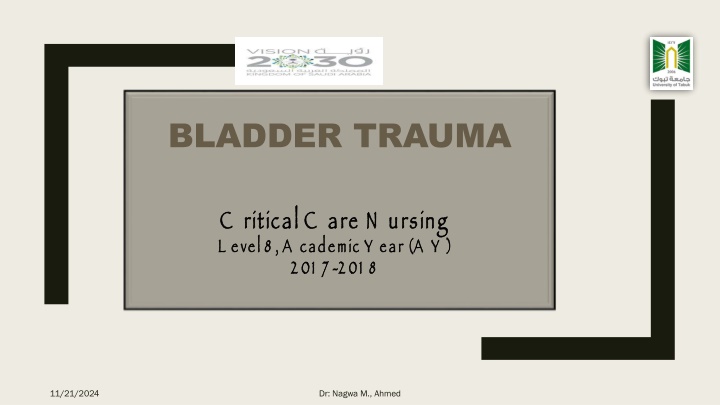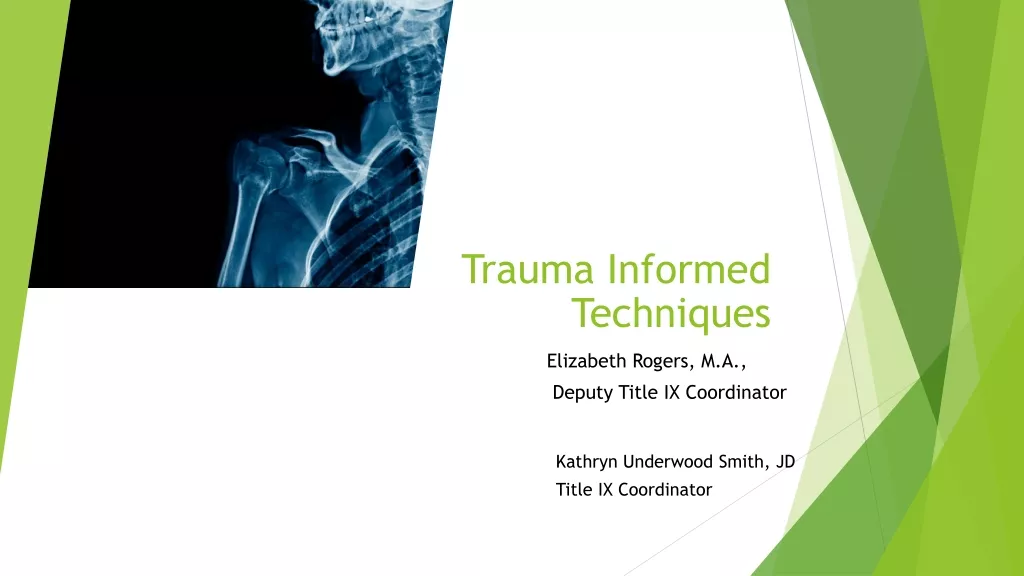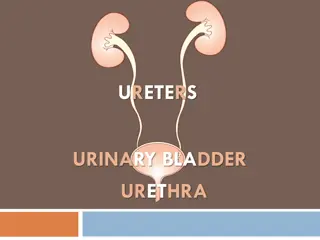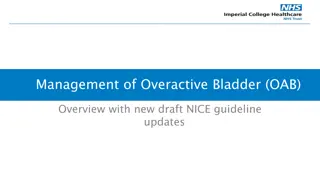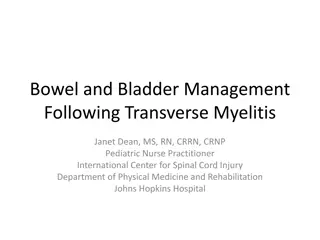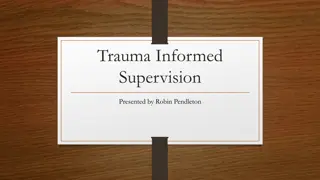Bladder Trauma: Etiology, Pathophysiology, and Management
Bladder trauma commonly occurs due to pelvic trauma or surgical interventions, leading to injuries like contusion, intraperitoneal rupture, and extraperitoneal rupture. Dr. Nagwa M. Ahmed presents key elements of bladder trauma, including its etiology, pathophysiology, clinical presentation, diagnostic evaluation, and nursing diagnosis. Learn to identify and manage bladder trauma conditions effectively.
Download Presentation

Please find below an Image/Link to download the presentation.
The content on the website is provided AS IS for your information and personal use only. It may not be sold, licensed, or shared on other websites without obtaining consent from the author.If you encounter any issues during the download, it is possible that the publisher has removed the file from their server.
You are allowed to download the files provided on this website for personal or commercial use, subject to the condition that they are used lawfully. All files are the property of their respective owners.
The content on the website is provided AS IS for your information and personal use only. It may not be sold, licensed, or shared on other websites without obtaining consent from the author.
E N D
Presentation Transcript
BLADDER TRAUMA C ritical C are N ursing L evel 8 , A cademic Y ear (A Y ) 2 01 7 C ritical C are N ursing L evel 8 , A cademic Y ear (A Y ) 2 01 7 - -2 01 8 2 01 8 11/21/2024 Dr: Nagwa M., Ahmed
BLADDER TRAUMA 11/21/2024 Dr: Nagwa M., Ahmed
Learning Objectives: At the end of this lecture the students will be able to : Identify Bladder trauma condition Understand key elements of Bladder trauma (etiology, pathophysiology and clinical presentation) Identify diagnostic evaluation and management Identify nursing diagnosis for Bladder trauma 11/21/2024 Dr: Nagwa M., Ahmed
11/21/2024 Dr: Nagwa M., Ahmed
Bladder trauma Injuries to the bladder commonly occur along with pelvic trauma or may be due to surgical interventions. Injuries of the urinary bladder are caused by blunt or penetrating trauma. 11/21/2024 Dr: Nagwa M., Ahmed
ETIOLOGY ETIOLOGY Injuries to the bladder is commonly associated with pelvic fractures and multiple trauma. Certain surgical procedures (endoscopic urologic procedures, gynecologic surgery, caesarian section, surgery of the lower colon and rectum) also carry a risk of trauma to the bladder. 11/21/2024 Dr: Nagwa M., Ahmed
PATOPHYSIOLOGY PATOPHYSIOLOGY Bladder injuries are classified as follows: Bladder injuries are classified as follows: a. Contusion of bladder b. Intraperitoneal rupture. c. Extra peritoneal rupture. d. Combination intraperitoneal and extraperitoneal bladder rupture 11/21/2024 Dr: Nagwa M., Ahmed
Intraperitoneal bladder Rupture Intraperitoneal bladder Rupture rupture occurs when the bladder is full of urine and the lower abdomen sustains blunt trauma. The bladder ruptures as its weakest point, the dome. Urine and blood extravasates in to the peritoneal cavity. Extraperitoneal Extraperitoneal bladder bladder Rupture Rupture rupture occurs when the lower bladder is perforated by a bony fragment during pelvic fracture / with a sharp instrument during surgery. Urine and blood extravasate in to the pelvic cavity. 11/21/2024 Dr: Nagwa M., Ahmed
CLINICAL MANIFESTATIONS CLINICAL MANIFESTATIONS Inability to void Hematuria; presence of blood at urinary meatus Suprapubic pain and tenderness Rigid abdomen indicates intraperitoneal rupture. 11/21/2024 Dr: Nagwa M., Ahmed
DIAGNOSTIC EVALUATION DIAGNOSTIC EVALUATION Cystogram Cystogram to detect and localize perforation / rupture of bladder Plain film of abdomen Plain film of abdomen may show associated pelvic fracture 11/21/2024 Dr: Nagwa M., Ahmed
MANAGEMENT MANAGEMENT Treatment instituted for shock and hemorrhage. Surgical intervention carried out for intraperitoneal bladder rupture. Extravasated blood and urine will first be drained and urine diverted with suprapubic cystostomy / indwelling catheter. Small extraperitoneal bladder ruptures will heal spontaneously with indwelling suprapubic / urethral catheter drainage. Large extraperitoneal bladder ruptures are repaired surgically 11/21/2024 Dr: Nagwa M., Ahmed
NURSING DIAGNOSES Risk for Deficient Fluid Volume related to trauma and resulting hemorrhage. Impaired Urinary Elimination related to disruption of intact lower urinary tract. Acute pain related to traumatic injury. Fear related to traumatic injury and uncertain prognosis. 11/21/2024 Dr: Nagwa M., Ahmed
NURSING INTERVENTIONS Stabilizing Stabilizing Circulatory Circulatory Volume Volume 1. Monitor vital signs and CVP frequently as indicated by condition. 2. Establish IV access, and replace blood and fluids as ordered. 11/21/2024 Dr: Nagwa M., Ahmed
Facilitating Facilitating Urinary Elimination Urinary Elimination 1. Obtain urine specimen, if possible, and assess for degree of hematuria and presence of infection. 2. Prepare patient for surgical repair by assisting with preoperative workup and describing postoperative experiences. 3. Postoperatively, maintain patency and flow of indwelling urinary catheters. 4. Inspect suprapubic incision and drains from perivesical areas for bleeding, extravasation of urine, or signs of infection. 11/21/2024 Dr: Nagwa M., Ahmed
Controlling Controlling Pain 1. Administer analgesics as ordered (when pt s vital signs are stable). 2. Assess pt s response to pain control medications. 3. Position for comfort (usually semi fowler s position) if not contraindicated by other injuries, and prevent pulling of catheter tubing. Pain 11/21/2024 Dr: Nagwa M., Ahmed
Relieving Relieving Fear 1. Provide information to the conscious pt throughout the stabilization and evaluation phase; prepare for surgery if impending. 2. Keep pt s family / significant others informed of condition and progress. 3. Provide information on long term outcome of treatment. Fear 11/21/2024 Dr: Nagwa M., Ahmed
